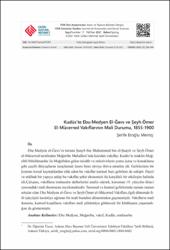| dc.contributor.author | Eroğlu Memiş, Şerife | |
| dc.date.accessioned | 2021-06-25T10:11:42Z | |
| dc.date.available | 2021-06-25T10:11:42Z | |
| dc.date.issued | 2020 | en_US |
| dc.identifier.citation | EROĞLU MEMİŞ, Şerife. "Kudüs’te Ebu Medyen El-Ğavs ve Şeyh Ömer El-Mücerred Vakıflarının Mali Durumu, 1855-1900." FSM İlmi Araştırmalar İnsan ve Toplum Bilimleri Dergisi, 17 (2021): 355-414. | en_US |
| dc.identifier.uri | https://dergipark.org.tr/tr/pub/fsmia/issue/62991/957097 | |
| dc.identifier.uri | https://hdl.handle.net/11352/3687 | |
| dc.description.abstract | Ebu Medyen el-Ğavs’ın torunu Şuayb bin Muhammed bin el-Şuayb ve Şeyh Ömer
el-Mücerred tarafından Meğaribe Mahallesi’nde kurulan vakıflar, Kudüs’te mukîm Mağribli
Müslümanlar ile Mağribden gelen misâfir ve mücâvirlerin yeme-içme ve konaklama
gibi çeşitli ihtiyaçlarını karşılamak üzere birer zâviye ihtiva etmekte idi. Gelirlerinin bir
kısmını kırsal kaynaklardan elde eden bu vakıflar kentsel bazı gelirlere de sahipti. Hayrî
ve mülhak bir yapıya sahip bu vakıflar şehir ekonomisi ile karşılıklı bir etkileşim halinde
idi.Çalışma, vakıfların muhasebe defterlerini analiz ederek, kurumun 19. yüzyılın ikinci
yarısındaki mali durumunu incelemektedir. Tarımsal ve kentsel gelirlerinde zaman zaman
artışlar olan Ebu Medyen el-Ğavs ve Şeyh Ömer el-Mücerred Vakıfları,ilgili dönemde fiili
işleyişini kesintiye uğratan bir mali bunalım döneminden geçmemiştir. Vakıfların mali
durumu, kentsel koşulların vakıfları mali çöküntüye götürecek bir kötüleşme yaşamadığını
da göstermiştir. | en_US |
| dc.description.abstract | The waqfs, established by Abu Madyan Shuayb al-Maghribi,the grandson of Abu
Madyan al-Ghawth, and Sheikh ‘Umar al-Mujarrad, in the Maghariba neighborhood in
Jerusalem, included one lodge each to meet the various needs of Maghribi Muslims residing
in Jerusalem, as well as guests and adjacents from the Maghrib, such as eating, drinking
and accommodation. These waqfs, which collected a part of their income from rural
sources, also had some urban incomes. Those, which were among charitable endowments
and managed by the persons stipulated in their waqfiyyas were in mutual interaction with
the economic conditions in the city.This study is to analyze the financial situation of the
institutions in the second half of the 19th century by analyzing the waqfs’ accounting
books. It reveals that while the agricultural and urban income of the waqfs increased from
time to time, this did not bring about a period of financial crisis that interrupted their actual
functioning. The financial situation of the waqf salso shows that the urban conditions
did not deteriorate, which would lead to a financial collapse for both. | en_US |
| dc.language.iso | tur | en_US |
| dc.publisher | FSM Vakıf Üniversitesi | en_US |
| dc.relation.isversionof | 10.16947/fsmia.957097 | en_US |
| dc.rights | info:eu-repo/semantics/openAccess | en_US |
| dc.subject | Ebu Medyen | en_US |
| dc.subject | Meğaribe | en_US |
| dc.subject | Vakıf | en_US |
| dc.subject | Kudüs | en_US |
| dc.subject | Muhasebe | en_US |
| dc.subject | Abu Madyan | en_US |
| dc.subject | Maghariba | en_US |
| dc.subject | Waqf | en_US |
| dc.subject | Jerusalem | en_US |
| dc.subject | Accounting | en_US |
| dc.title | Kudüs’te Ebu Medyen El-Ğavs ve Şeyh Ömer El-Mücerred Vakıflarının Mali Durumu, 1855-1900 | en_US |
| dc.title.alternative | Financial Situation of the Waqfs of Abu Madyan Al-Ghawth and Sheikh ‘Umar Al-Mujarrad in Jerusalem, 1855-1900 | en_US |
| dc.type | article | en_US |
| dc.relation.journal | FSM Vakıf Üniversitesi, FSM İlmî Araştırmalar İnsan ve Toplum Bilimleri Dergisi | en_US |
| dc.contributor.department | FSM Vakıf Üniversitesi, Rektörlük, FSM İlmî Araştırmalar İnsan ve Toplum Bilimleri Dergisi | en_US |
| dc.contributor.authorID | https://orcid.org/0000-0003-2880-8602 | en_US |
| dc.identifier.issue | 17 | en_US |
| dc.identifier.startpage | 355 | en_US |
| dc.identifier.endpage | 414 | en_US |
| dc.relation.publicationcategory | Makale - Ulusal Hakemli Dergi - Başka Kurum Yazarı | en_US |



















